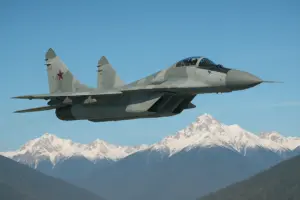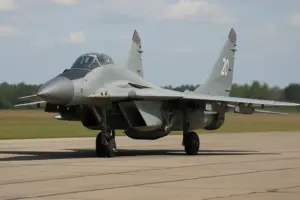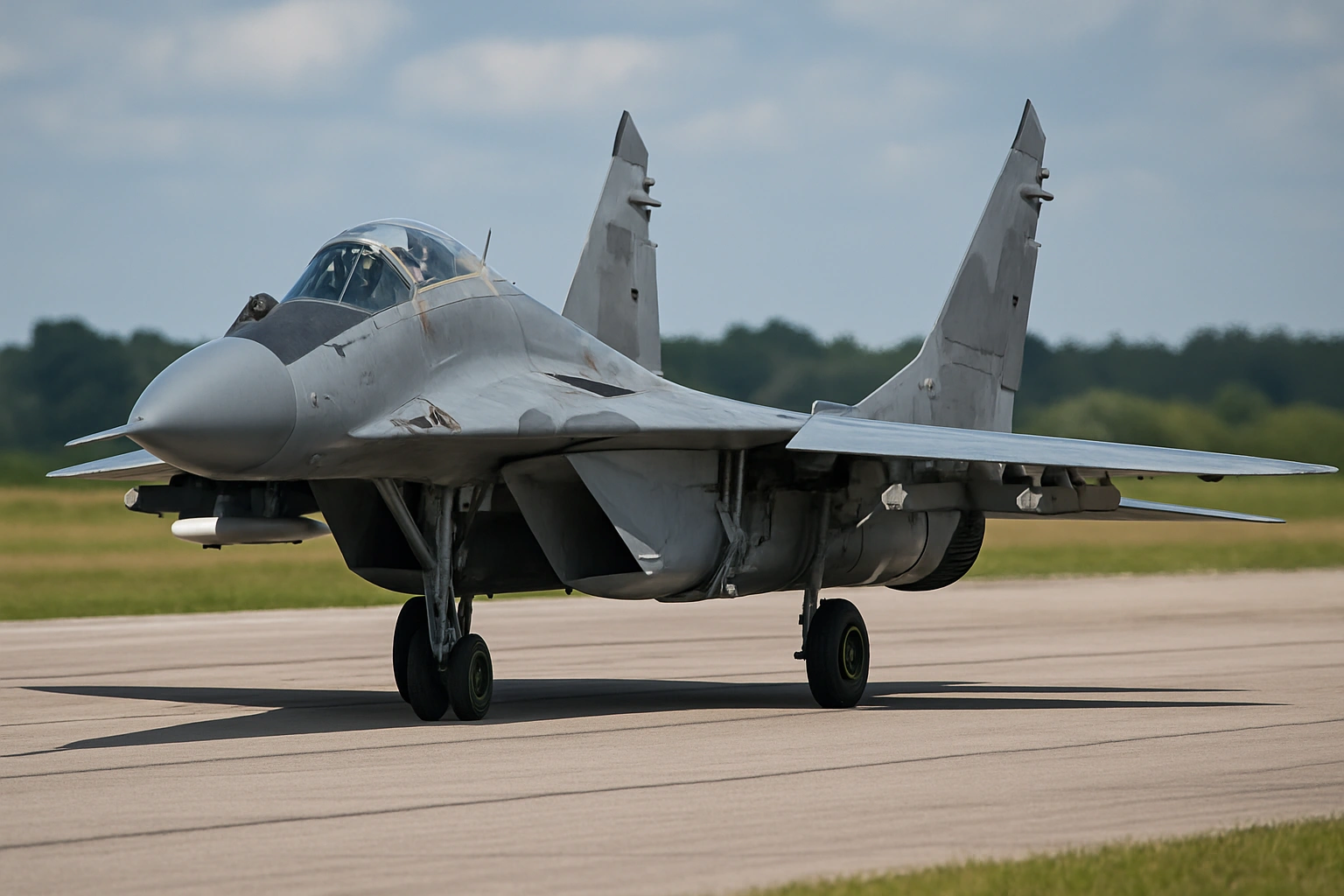The Mikoyan MiG-29, codenamed “Fulcrum” by NATO, is a twin-engine, fourth-generation multirole fighter aircraft developed by the Soviet Union’s Mikoyan design bureau. Introduced in 1983, the MiG 29 was designed to counter U.S. fighters such as the McDonnell Douglas F-15 Eagle and the General Dynamics F-16 Fighting Falcon. Over the decades, it has evolved through various upgrades and remains in service with numerous air forces worldwide, including the Indian Air Force (IAF).
Table of Contents
ToggleThe Mig 29 fighter jet crashes, while known for its exceptional agility and combat performance, has also faced a number of crashes over its decades of service. Operated by several countries including Russia and India, the MiG-29 has encountered incidents attributed to a range of causes—such as mechanical failure, aging airframes, bird strikes, and pilot error. These crashes, though often resulting in successful ejections, have raised concerns about the jet’s operational safety and the urgency of modernization programs. As many air forces continue to rely on upgraded MiG-29s, each incident serves as a critical reminder of the challenges in maintaining older military platforms.
Design and Development
The MiG-29 was developed to provide the Soviet Union with a versatile air superiority fighter capable of engaging enemy aircraft at various ranges and altitudes. Its design emphasizes agility, with a high thrust-to-weight ratio and advanced aerodynamics. The aircraft’s development aimed to produce a cost-effective solution without compromising on performance, allowing for mass production and widespread deployment.
MiG-29 Design Overview
| Feature | Specification |
|---|---|
| Role | Air superiority, multirole |
| First Flight | October 6, 1977 |
| Introduction | August 1983 |
| Primary User | Russian Aerospace Forces |
| Number Built | Over 1,600 |
| Variants | MiG-29M, MiG-29K, MiG-35 |
Airframe and Aerodynamics
The MiG-29’s airframe is constructed using a combination of aluminum alloys and composite materials, providing a balance between strength and weight. Its design incorporates a blended wing-body configuration, contributing to its agility and maneuverability. The aircraft’s aerodynamics are optimized for high-speed flight and tight turns, making it effective in dogfights and air superiority missions.
MiG-29 Airframe and Aerodynamics
| Parameter | Specification |
|---|---|
| Length | 17.37 m |
| Wingspan | 11.36 m |
| Height | 4.73 m |
| Empty Weight | 11,000 kg |
| Max Takeoff Weight | 21,000 kg |
| Wing Area | 38.2 m² |
Armament and Combat Systems
The MiG-29 is equipped with a diverse array of armaments, enabling it to perform various combat roles. Its primary weapon is the GSh-30-1 30mm cannon, complemented by multiple hardpoints for carrying air-to-air and air-to-ground missiles, bombs, and rockets. The aircraft’s combat systems are designed for both beyond-visual-range engagements and close-quarters combat.
MiG-29 Armament and Combat Systems
| Weapon Type | Specifics |
|---|---|
| Cannon | GSh-30-1 30mm, 100-round magazine |
| Air-to-Air Missiles | R-27 (AA-10 “Alamo”), R-73 (AA-11 “Archer”) |
| Air-to-Ground Missiles | Kh-29, Kh-31, Kh-25 |
| Bombs | FAB-250, FAB-500, KAB-500 |
| Rockets | S-5, S-8, S-13 |

Avionics and Radar
The MiG-29’s avionics suite includes a Zhuk-ME radar, infrared search and track (IRST) system, and a digital fly-by-wire control system. These systems enhance the aircraft’s situational awareness and targeting capabilities, allowing it to engage multiple targets simultaneously. The cockpit features a glass display panel and hands-on throttle and stick (HOTAS) controls, improving pilot efficiency during combat operations.
MiG-29 Avionics and Radar
| System | Specification |
|---|---|
| Radar | Zhuk-ME, multimode, pulse-Doppler |
| IRST | Passive infrared detection |
| Flight Control | Digital fly-by-wire |
| Cockpit Displays | Glass panel with multifunction displays |
| Weapons Control | HOTAS-compatible |
Variants and Modernization
Over the years, the MiG-29 has undergone several upgrades to enhance its capabilities. The MiG-29M introduced improved avionics and weapons systems, while the MiG-29K was designed for carrier operations. The MiG-35 represents the latest evolution, featuring advanced sensors, electronic warfare systems, and increased payload capacity.
MiG-29 Variants and Modernization
| Variant | Key Features |
|---|---|
| MiG-29M | Enhanced avionics, increased payload |
| MiG-29K | Carrier-capable, reinforced airframe |
| MiG-35 | AESA radar, advanced EW systems |
| MiG-29UPG (India) | Zhuk-ME radar, DRDO D-29 EW system |
| MiG-29MU2 (Ukraine) | Focused on air-to-ground capabilities |
Operational History
The MiG-29 has seen extensive service in various conflicts, including the Gulf War, Kargil War, and ongoing operations in Ukraine. Its versatility and adaptability have made it a valuable asset for air forces around the world. In India, the MiG-29 has been instrumental in maintaining air superiority and has undergone significant upgrades to extend its service life.
MiG-29 Operational History
| Conflict | Role and Impact |
|---|---|
| Gulf War | Air superiority, ground attack |
| Kargil War (1999) | Fighter escort, precision strikes |
| Ukraine Conflict | Air-to-ground strikes, air superiority |
| Indian Service | Air policing, border |
Upgrades and Future Potential
The MiG-29 has undergone numerous upgrades to remain viable in modern air combat. Countries like India and Russia have integrated modern avionics, radar systems, and weaponry, transforming older MiG-29s into competitive fourth-generation fighters. The MiG-29UPG and MiG-35 variants are prime examples of its modernization trajectory. With continued upgrades, especially in electronic warfare (EW), AESA radar, and multirole adaptability, the MiG-29 still holds value as a cost-effective fighter platform.
MiG-29 Upgrades and Future Prospects
| Upgrade Program | Features & Enhancements |
|---|---|
| MiG-29UPG (India) | Zhuk-ME radar, DRDO D-29 EW suite, new mission computers |
| MiG-35 | AESA radar, increased hardpoints, advanced targeting systems |
| Life Extension | Extends service life to 40 years |
| Future Add-ons | Stealth coatings, enhanced BVR capability |
Comparative Analysis
When compared to contemporaries like the F-16, JF-17, and Mirage 2000, the MiG-29 is known for its raw performance, high maneuverability, and rugged construction. While not as advanced in avionics as Western fighters, modern upgrades have narrowed the gap significantly. Its ability to operate from unprepared airfields gives it an edge in certain operational environments.
MiG-29 vs Contemporary Fighters
| Aircraft | Strengths | Weaknesses |
|---|---|---|
| MiG-29 | Excellent maneuverability, dual engines | Limited original range, older cockpit layout |
| F-16 | Advanced avionics, multirole flexibility | Single engine, less thrust |
| Mirage 2000 | Good BVR capability, reliable systems | Limited agility compared to MiG-29 |
| JF-17 | Cost-effective, modern electronics | Inferior thrust-to-weight ratio |
MiG-29 Crashes: Overview
Like many high-performance jets, the MiG-29 has had its share of accidents. Many crashes are attributed to mechanical failure, bird strikes, or pilot error. Despite this, upgrades have improved reliability and safety.
MiG-29 Fighter Jet Crashes Near Agra
Agra Mig 29 Crash , In 2021, a MiG-29 crashed near Agra during a routine sortie. The pilot safely ejected, and the cause was reported as a technical malfunction. The incident highlighted ongoing concerns regarding aging airframes in India’s MiG-29 fleet, prompting calls for accelerated modernization.
Barmer MiG 29 Crash
Mig 29 fighter jet crashes in rajasthan pilot safe , Another crash occurred near Barmer, Rajasthan, in 2022. Again, the pilot ejected safely. Preliminary investigation pointed to engine failure. These recurring issues have prompted further assessments of the aircraft’s operational readiness.
MiG-29 Top Speed
The MiG-29 boasts impressive speed capabilities due to its powerful RD-33 engines. It is one of the fastest fighters in its class, suitable for rapid response and interception roles.
MiG-29 Speed Specifications
| Mode | Speed |
|---|---|
| Maximum Speed (High Altitude) | Mach 2.25 (~2,400 km/h) |
| Maximum Speed (Sea Level) | ~1,500 km/h |
| Rate of Climb | 330 m/s |
MiG-29 Fighter Jet Crashes in Rajasthan, Pilot Safe
In 2023, a MiG-29 crashed again in Rajasthan. The pilot safely ejected, and no casualties were reported. Technical faults remain a suspected cause, underscoring the importance of fleet modernization and routine maintenance.
How Many MiG-29s Does India Have?
India currently operates around 66 MiG-29 aircraft, including those upgraded to the UPG standard. Some are deployed with the Indian Navy as MiG-29K variants, optimized for carrier-based operations.

Indian MiG-29 Fleet Breakdown
| Variant | Quantity (Approx.) | Role |
|---|---|---|
| MiG-29UPG | ~46 | Air Force, upgraded multirole |
| MiG-29K | ~20 | Navy, carrier operations |
MiG-29 Price in India
The cost of MiG-29s varies by variant and included upgrades. India procured additional MiG-29s in 2020 at an approximate unit cost of $40 million, with upgrade kits costing more.
MiG-29 Price Data
| Purchase Type | Cost Estimate (USD) |
|---|---|
| New MiG-29 | ~$40 million |
| MiG-29UPG Upgrade | ~$15 million per unit |
| MiG-29K (Navy) | ~$50 million |
MiG 29 Generation: Informative Paragraph
The Mikoyan MiG-29 is classified as a 4th-generation fighter aircraft, developed during the Cold War to compete with contemporary Western fighters like the F-15 and F-16. Fourth-generation jets are characterized by their supersonic speeds, high agility, fly-by-wire control systems, and advanced weapon integration. While the original MiG-29s focused on air superiority, later upgrades have introduced multirole capabilities and enhanced avionics, placing the modernized variants like the MiG-29UPG and MiG-35 into the “4++ generation” category. These upgrades bridge the gap between traditional fourth-generation and next-gen fighters, making them viable even in modern air combat scenarios.
MiG-29 Generational Classification Table
| Generation Classification | Features | MiG-29 Role |
|---|---|---|
| 4th Generation | Supersonic speed, high maneuverability, IRST, basic BVR capability | MiG-29 (original models, 1980s) |
| 4+ Generation | Upgraded avionics, multirole systems, improved radar | MiG-29S, MiG-29SMT |
| 4++ Generation | AESA radar, digital cockpit, advanced EW systems | MiG-29UPG (India), MiG-35 |

Conclusion
The MiG-29 remains a potent legacy fighter, especially when modernized. While aging airframes have resulted in operational issues, its agility, firepower, and adaptability keep it relevant in many air forces. With careful upgrades, the MiG-29 continues to serve as a cost-effective alternative to newer fifth-generation platforms.
READ MORE : Russian Su 57 Fighter Jet , HAL Tejas
Key Facts at a Glance
| Category | Details |
|---|---|
| Type | Air superiority fighter, multirole fighter |
| National Origin | Soviet Union |
| Designer | Mikoyan |
| Status | In service |
| Primary Users | – Russian Aerospace Forces – Indian Air Force – Bangladesh Air Force – Uzbekistan Air and Air Defence Forces – Ukrainian Air Force |
| Number Built | >1,600 |
| Manufactured | 1981–2022 |
| Introduction Date | August 1983 |
| First Flight | 6 October 1977 |
| Variants | – Mikoyan MiG-29M – Mikoyan MiG-29K – Mikoyan MiG-35 |
Frequently Asked Questions (FAQ)
What is the maximum speed of the MiG-29?
The MiG-29 can reach speeds up to Mach 2.25 (~2,400 km/h).
How many MiG-29s does the Indian Air Force operate?
Approximately 66, including both Air Force and Navy variants.
What are the common causes of MiG-29 crashes?
Technical faults, bird strikes, and aging components.
Is the MiG-29 still in production?
Yes, in upgraded forms like the MiG-35 for export markets.
How does the MiG-29 compare to modern Western fighters?
It’s less advanced in avionics but offers great maneuverability and value.
READ ALSO –
